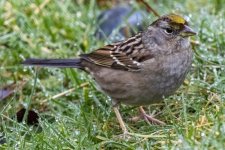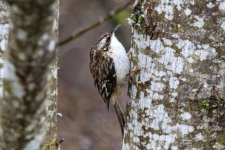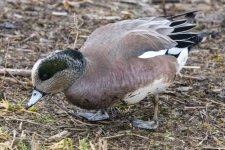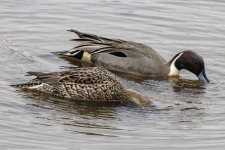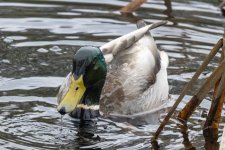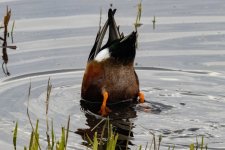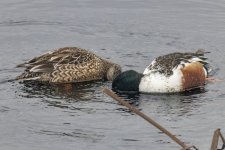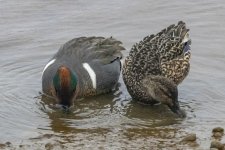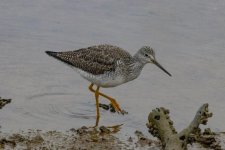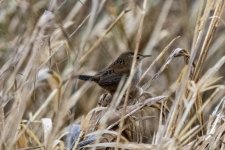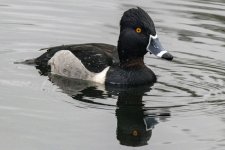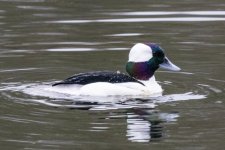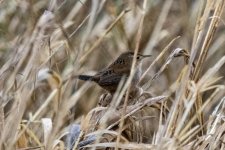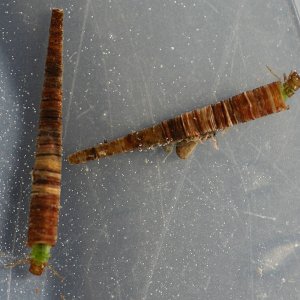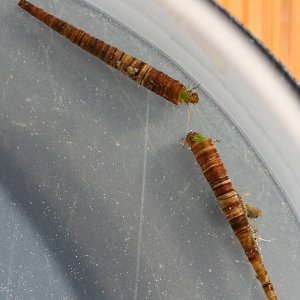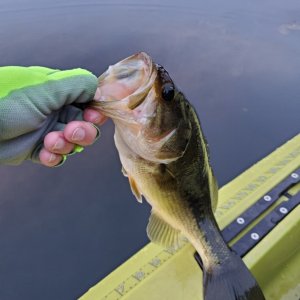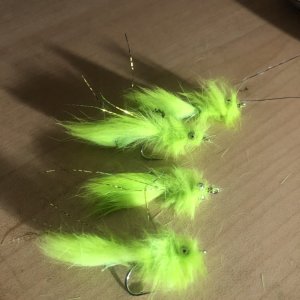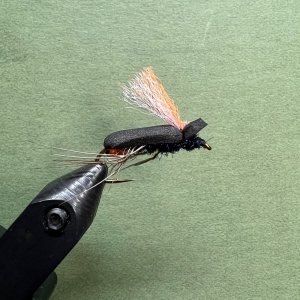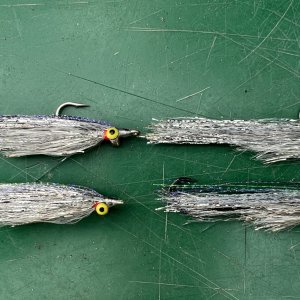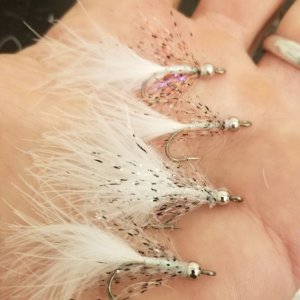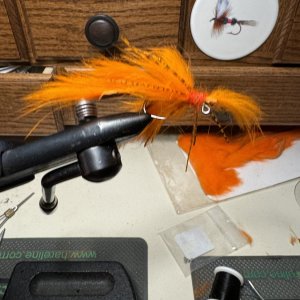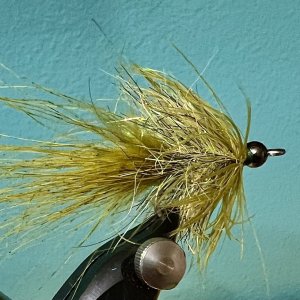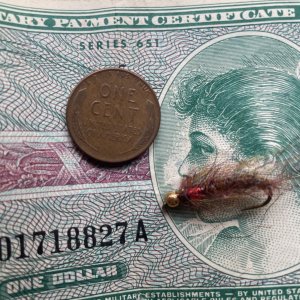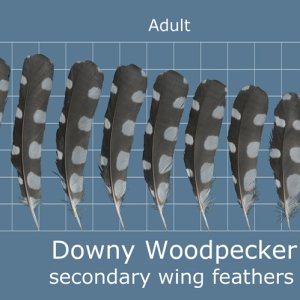[Part 1 0f 3] With the prospect of a drizzly holiday weekend on tap (and over her birthday to boot), my wife and I found that we both had no meetings or appointments on Friday morning. So, off on an adventure to the Billy Frank Jr. Nisqually Wildlife Refuge. We had actually tried to visit the refuge in late morning the previous sunny weekend, but even after two circuits of the parking lots, there weren’t any spaces. We left. [And we were shut out of Tolmie State Park too. The sun brings every Washingtonian out of their caves this time of year.]. But, an overcast early Friday morning is a great time to visit Nisqually.
We hadn’t even parked when I almost drove us off the road as I saw a male hooded merganser in the pond by the Visitor Center. We quickly parked, geared up, and fast-marched back to the pond. Before we got there though, a spotted towhee male popped out as if to say “Look at me. I’m in fine plumage too.”.
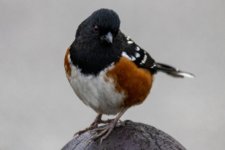
A pair of hooded mergansers were diving in the pool by the entrance to the visitor center. Often both the drake and the hen would dive synchronously as if practicing for the Summer Olympics. The drake posed for several pictures while the hen dove under the bridge that bisects the pool and foraged alone on that far side.
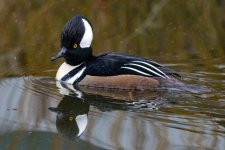
From the viewing platform at the Visitor Center that overlooks the main pond, we could see several mallard pairs that were scattered about feeding. I think that the ducks may know that hunting season is over as they appear to be a bit less skittish than they were a few weeks earlier.
We decide to hike the Twin Barns loop trail in the counter-clockwise direction. We saw a few song sparrows as we walked down the leg toward the dike by the Nisqually River. There wasn’t any bird activity on the riparian spur trail but we did find several osoberry = Indian plum shrubs (Oemleria cerasiformes) in bloom
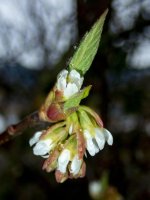
as well as some salmonberry (Rubus spectabilis) flowers.
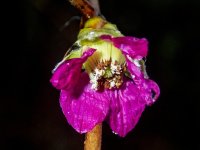
So, the calendar might say mid-February, but the vegetation (and some of the bird activity) is reflecting spring. With the deciduous trees and shrubs bare at present, the lichens, mosses and fungi stood out even more than they would when everything has leafed out and there are flowers and fruits present.
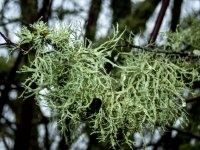
Except for the starlings calling high in the trees, the walk along the canal to the west was quiet. We have recently read reports online of folks spotting several owl species, including great horned owls, short-eared owls, and Northern saw-whet owl. We scanned the trees carefully, but finding a camouflaged owl against a tree trunk or on a side branch makes finding a needle in a haystack an easy task.
So, when we encountered a group of robins squawking at the junction of the western dike trail and the gravel N-S dike trail, we kept our eyes peeled for an owl that might be the nexus of this ruckus.
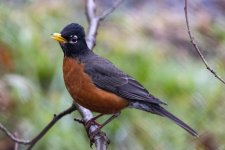
Adding to the noise, a Bewick’s wren was calling in the mix.
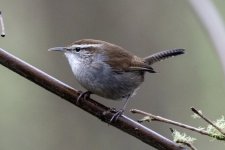
In the end, it just appeared that the robins were jousting with each other – spring hormones. A pair of hairy woodpeckers were foraging in the same area.
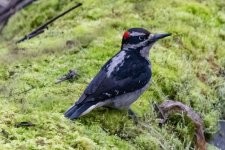
Steve
We hadn’t even parked when I almost drove us off the road as I saw a male hooded merganser in the pond by the Visitor Center. We quickly parked, geared up, and fast-marched back to the pond. Before we got there though, a spotted towhee male popped out as if to say “Look at me. I’m in fine plumage too.”.

A pair of hooded mergansers were diving in the pool by the entrance to the visitor center. Often both the drake and the hen would dive synchronously as if practicing for the Summer Olympics. The drake posed for several pictures while the hen dove under the bridge that bisects the pool and foraged alone on that far side.

From the viewing platform at the Visitor Center that overlooks the main pond, we could see several mallard pairs that were scattered about feeding. I think that the ducks may know that hunting season is over as they appear to be a bit less skittish than they were a few weeks earlier.
We decide to hike the Twin Barns loop trail in the counter-clockwise direction. We saw a few song sparrows as we walked down the leg toward the dike by the Nisqually River. There wasn’t any bird activity on the riparian spur trail but we did find several osoberry = Indian plum shrubs (Oemleria cerasiformes) in bloom

as well as some salmonberry (Rubus spectabilis) flowers.

So, the calendar might say mid-February, but the vegetation (and some of the bird activity) is reflecting spring. With the deciduous trees and shrubs bare at present, the lichens, mosses and fungi stood out even more than they would when everything has leafed out and there are flowers and fruits present.

Except for the starlings calling high in the trees, the walk along the canal to the west was quiet. We have recently read reports online of folks spotting several owl species, including great horned owls, short-eared owls, and Northern saw-whet owl. We scanned the trees carefully, but finding a camouflaged owl against a tree trunk or on a side branch makes finding a needle in a haystack an easy task.
So, when we encountered a group of robins squawking at the junction of the western dike trail and the gravel N-S dike trail, we kept our eyes peeled for an owl that might be the nexus of this ruckus.

Adding to the noise, a Bewick’s wren was calling in the mix.

In the end, it just appeared that the robins were jousting with each other – spring hormones. A pair of hairy woodpeckers were foraging in the same area.

Steve

